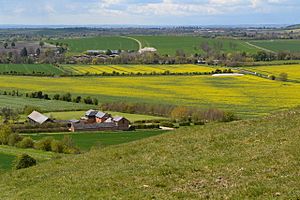All Cannings Cross facts for kids
All Cannings Cross is the name of a farm and an important archaeological site located near the village of All Cannings, close to Devizes in Wiltshire, England. This special place is officially protected as a scheduled ancient monument.
Contents
Uncovering the Iron Age
All Cannings Cross is very important because it was the first place in Britain where archaeologists found clear evidence of the Iron Age beginning. This was a time when people started using iron tools instead of bronze.
In 1911, two archaeologists, Ben and Maud Cunnington, began investigating the site. They heard that many hammerstones (tools used for hammering) were being found in a field in the Vale of Pewsey.
What the Cunningtons Found
When the Cunningtons started digging, they discovered a thick layer of dark, earthy material. This layer was full of interesting things! They found lots of pottery, animal bones, and tools made from both bronze and iron.
Based on their finds, they estimated the site dated back to around 500 BC. This was a key time when Britain was moving from the Bronze Age into the Iron Age.
Amazing Pottery Discoveries
The Cunningtons returned to All Cannings Cross between 1920 and 1922 to continue their work. They dug up a huge amount of pottery, which helped experts understand this period much better.
Pottery Styles and Trade
From about the 8th century to the 7th century BC, the area known as Wessex (in southern England) had many different types of pottery. These pots were often beautifully decorated and very well made. Some were even covered with iron oxide and fired in a way that made them shine like bronze!
This special pottery is named after All Cannings Cross, which is its "typesite." This means it's the main place where this style of pottery was first identified. Since then, similar pottery has been found across southern Britain, from the Somerset Levels to eastern Hampshire.
This wide spread of pottery suggests that communities in the region were in close contact. They likely traded goods, especially bronze, and shared similar ideas and styles.
What Was the Settlement Like?
Archaeologists have found signs of buildings made with wooden posts, along with other features like hearths (fireplaces) and floors. This tells us that people lived here long ago.
The Mystery of the Middens
More recently, in 2003 and 2004, researchers from the University of Sheffield studied the site again. They think the thick layer of earthy material the Cunningtons found might be part of large "middens." Middens are basically ancient rubbish heaps. Similar middens have been found at nearby sites like Potterne and East Chisenbury.
It's still a bit of a mystery exactly what the settlement was like. We don't know for sure if these middens were just everyday waste from farming, or if they were created for special reasons, perhaps during big group feasts or rituals.
See Also


